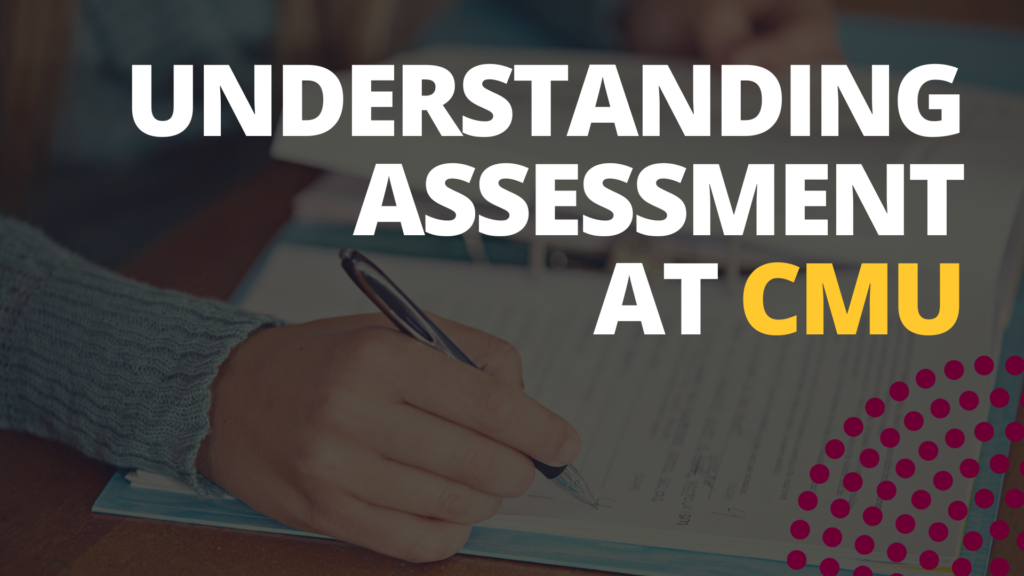Author: Megan Biller, Ed.D – Director of Assessment & Curriculum, Office of Curriculum and Instructional Support
What is Assessment of Student Learning?
At its core, assessment involves collecting, reviewing, and using information and data to improve student learning (Astin, 1991; Palomba & Banta, 1999). One of the primary purposes of assessment of student learning is to enhance the student’s development and mastery of concepts while advancing the institution’s goals (Astin, 1991). Suskie (2019b) stated an additional purpose of assessment is to provide faculty and students with feedback on what is working or not working to make the appropriate changes to ensure student success. Effective assessment should lead to results that are useful and used, focus on clear goals, be cost-effective, and be a part of everyday life within the institution (Suskie, 2019a). Assessment should always focus on improving student learning and strengthening student success (Driscoll et al., 2021).
At CMU, assessment is defined as the ongoing monitoring of the extent to which students develop the knowledge, skills, beliefs, and attitudes appropriate for graduates of their respective academic programs (CMU Curriculum Authority Document (CAD), Appendix E). It is a collaborative effort, including the input of multiple stakeholders. The Assessment Council (CMICH Login Required) is a committee of the Academic Senate comprised of eleven voting members. Their charge includes (but is not limited to) developing learning assessment policies, reviewing and approving assessment plans, and advocating for university resources to support involvement in assessment activities. Additionally, each college has an assessment coordinator (CMICH Login Required) that assists with student learning outcomes, assessment plans, and assessment reporting.
Why Assessment is Important
The information and data used for assessment purposes is continually gathered by faculty as part of their teaching, both formally and informally. Taking the information, reviewing, and using it to improve student learning is part of the assessment process. Driscoll et al. (2021) states, “The best assessment is iterative, ongoing, and supplies data that urge immediate support for our students” (p. 29). There are many ways to take the information gathered and use it in a way that is beneficial for the faculty and students. Below are a few examples of reviewing and using assessment data:
- Individual reflection
- Example: examining assignment results and determining where students may have gaps.
- Group discussion
- Example: talking with colleagues about findings or experiences, learning from one another on how to improve student learning.
- Student feedback
- Example: through classroom activities or conversations with students, identify areas where students may need more information to fully understand a concept or outcome.
Below are a few ways that assessment can help programs:
- Find out what students are actually learning (versus what we think they are learning).
- Make changes to the curriculum or courses (fill in gaps, strengthen weak areas, etc.).
- Become better teachers (more effectively meet the needs of the students).
- Have empirical data about learning outcomes (show stakeholders what is working and plan for the future).
Introducing Planning and Self-Study
In the fall, Central Michigan University will be launching a new assessment system – Planning and Self-Study by Watermark. Within this system, programs can create and revise assessment plans, enter assessment results and analysis, submit annual assessment reports, and share assessment plans and findings with colleagues. Assessment information will be saved each academic year, with the information easily accessible for purposes such as accreditation or program review. As a reminder, annual assessment reports are due October 1. This year’s reports will be submitted through the new Planning and Self-Study system.
Upcoming Trainings
Numerous training sessions for Planning and Self-Study will take place in late August and early September. Register for these virtual trainings at CIS Events. Training materials such as user guides and videos will soon be available on the Planning and Self-Study Sharepoint site (CMICH Login Required).
Questions about assessment at CMU can be directed to your college assessment coordinator, an Assessment Council member, or by contacting CIS at cis@cmich.edu.
References
Astin, A. W. (1991). Assessment for excellence: The philosophy and practice of assessment and evaluation in higher education (1st ed.). New York, NY: Macmillan.
Driscoll, A., Graff N., Shapiro D., & Wood, S. (2021). Advancing assessment for student success. Sterling, VA: Stylus Publishing.
Palomba, C. A., & Banta, T. W. (1999). Assessment essentials: Planning, implementing, and improving assessment in higher education (1st ed.). San Francisco, CA: Jossey-Bass.
Suskie (2019, April 17). What is good assessment, revisited. (CMICH Login Required).
Suskie (2019, July 9). Why are you assessing. (CMICH Login Required).

